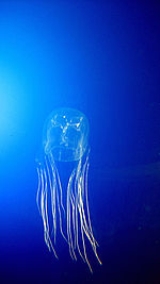
Chironex fleckeri
Overview
Box jellyfish
Box jellyfish are cnidarian invertebrates distinguished by their cube-shaped medusae. Box jellyfish are known for the extremely potent venom produced by some species: Chironex fleckeri, Carukia barnesi and Malo kingi are among the most venomous creatures in the world...
found in coastal waters from northern Australia
Australia
Australia , officially the Commonwealth of Australia, is a country in the Southern Hemisphere comprising the mainland of the Australian continent, the island of Tasmania, and numerous smaller islands in the Indian and Pacific Oceans. It is the world's sixth-largest country by total area...
and New Guinea
New Guinea
New Guinea is the world's second largest island, after Greenland, covering a land area of 786,000 km2. Located in the southwest Pacific Ocean, it lies geographically to the east of the Malay Archipelago, with which it is sometimes included as part of a greater Indo-Australian Archipelago...
north to the Philippines
Philippines
The Philippines , officially known as the Republic of the Philippines , is a country in Southeast Asia in the western Pacific Ocean. To its north across the Luzon Strait lies Taiwan. West across the South China Sea sits Vietnam...
and Vietnam
Vietnam
Vietnam – sometimes spelled Viet Nam , officially the Socialist Republic of Vietnam – is the easternmost country on the Indochina Peninsula in Southeast Asia. It is bordered by China to the north, Laos to the northwest, Cambodia to the southwest, and the South China Sea –...
. It has been described as "the most lethal jellyfish in the world", with at least 63 known deaths from 1884 to 1996.
Notorious for its sting, C. fleckeri has tentacles up to 3 metres (9.8 ft) long which are covered in thousands upon thousands of cnidocyte
Cnidocyte
A cnidocyte, cnidoblast, or nematocyte is a type of venomous cell unique to the phylum Cnidaria . The cnidocyte cell provides a means for them to catch prey and defend themselves from predators. Despite being morphologically simple, lacking a skeleton and usually being sessile, cnidarians prey on...
s which, on contact, release microscopic darts, each delivering an extremely powerful venom.
Unanswered Questions

